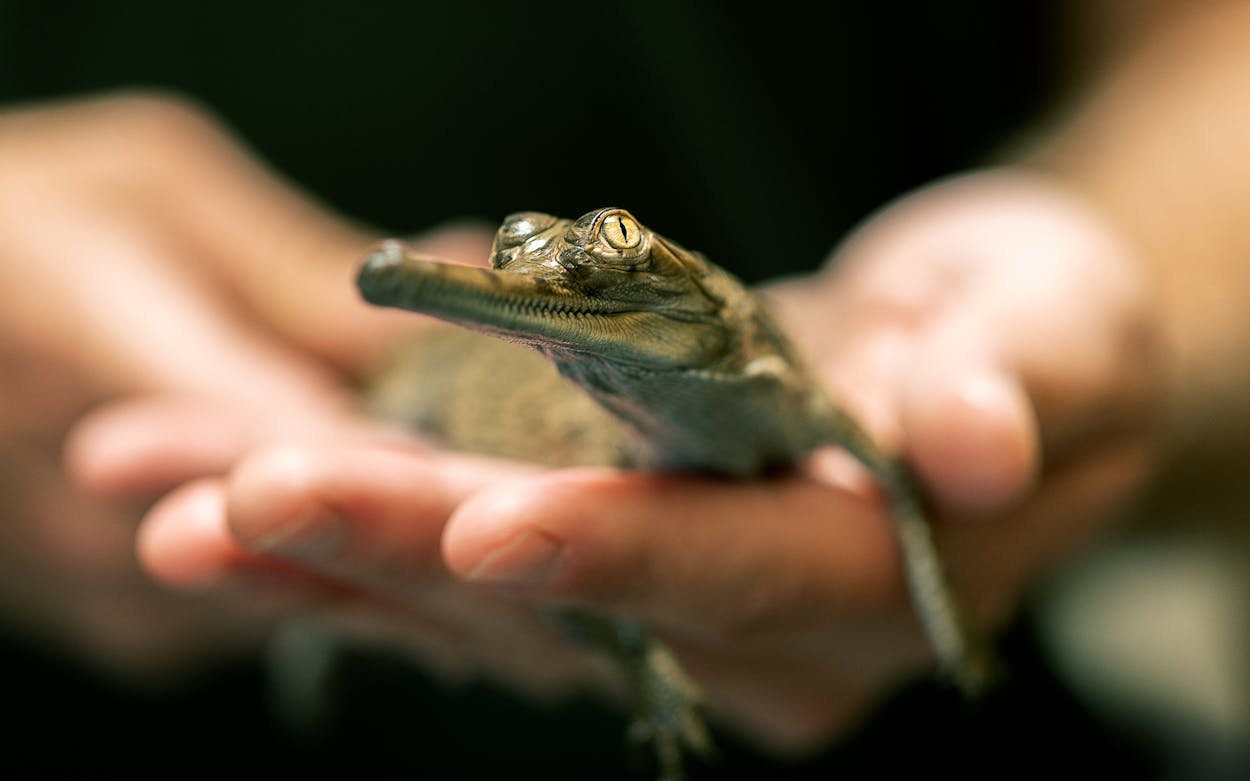WHO: New gharial moms Raani and Snaggle, father Big Boy (the biggest gharial in the U.S.), and the ectotherm keeper team at the Fort Worth Zoo.
WHAT: The zoo is now the first in the nation to breed multiple offspring of the critically endangered gharial, a crocodilian which is native to south Asia.
WHY IT’S SO GREAT: Gharials—freshwater reptiles with long, thin snouts and a bulbous nose (in males)—are at risk of vanishing. There are just 35 in captivity at North American zoos, and researchers estimate that between two hundred and five hundred adults live in the wild. Conservationists have long tried to breed the critters in captivity, but with little success.
Now the Fort Worth Zoo has successfully hatched four new gharials from two different mothers—named Raani and Snaggle—and a father named Big Boy, quadrupling the number born in the U.S. The little crocs don’t have names and they aren’t on display at the zoo yet, but their arrival marks a major step forward in the conservation of the species.
“We’ve all been trying to breed them for decades, with very, very limited success,” says Diane Barber, the zoo’s curator of ectotherms. Breeding gharials is tricky in part because the species has low fertility among clutches, meaning that many eggs either hatch too early or don’t hatch at all. So when tiny snouts and claws began to poke out from eggs in June and July, zookeepers rejoiced. “When we were making the calls to each other, we were literally jumping up and down,” Barber says.
This victory comes after several years of slow progress. The gharial breeding program started with a remodeled herpetarium, or reptile house, that the zoo opened in 2010. The gharial habitat was designed to have deep pools that allow them to swim vertically, which Barber says was how scientists thought they bred at the time. Now, thanks to the zoo’s big windows, they’ve been able to observe underwater mating behaviors in a horizontal position.
The habitat is carefully climate-controlled, too. The water is kept colder in the winter months, before keepers turn up the heat slowly to simulate the arrival of spring and encourage mating. Encouraging the crocs to lay their eggs in the right spot was the next hurdle. The three females in the habitat were laying eggs not in the sandy beach area of the habitat, but on the ground or in the water, where the eggs would not be viable. Barber’s team added heating coils to the sand to help make it just the right temperature for the females to feel comfortable.
In 2020, one female laid a large clutch of eggs. Getting that far was a big win for the Fort Worth team, but all were infertile. The next year, there were two clutches—58 eggs in all, and only three were fertile. Two of those eggs made it to full term, but never hatched. Last year was also a bust.
Then, earlier this year, keepers collected two clutches from Raani and Snaggle. Twelve of the eggs were fertile, and four have now hatched.
“With each sign of life, our superstitious anticipation grew, just like a baseball pitcher throwing a no-hitter game,” says Vicky Poole, the zoo’s associate curator of ectotherms. “We were all pretty emotional with each hatchling.”
Breeding programs like the Fort Worth Zoo’s follow rigorous standards set by groups including the Association of Zoos and Aquariums, and they’re working to bring back numerous struggling species. When I talked with Barber this week, she had just returned from a research trip to Mason Mountain Wildlife Management Area, in the western part of Central Texas, where she’s helping reintroduce the Texas horned lizard back to the landscape. Her goal is to release five hundred Fort Worth Zoo–bred hatchlings this year, part of an aggressive breeding program that brings together several of the state’s zoos.
Conservationists have a lot to consider when planning a breeding program. They start by sampling the animals’ DNA, and then they match mature adults based on genetic compatibility. It’s a little bit like online dating, but for critters. With the Texas horned lizard, that’s fairly easy. There are enough individuals in captivity to make unique pairings each year. But with so few gharials to choose from, matchmaking becomes a challenge. The new hatchlings, if they grow to maturity, will help diversify that available gene pool.


Only three other institutions have successfully hatched gharial babies worldwide. Two of those are in India and Nepal, where gharials are from. Only one other American zoo has successfully hatched a single gharial: the St. Augustine Alligator Farm Zoological Park, in Florida. In the wild, Barber said, gharial habitat has been decimated by salt mining and other pollution. The number of gharials began to plummet in the forties, and by the seventies, the population was just 2 percent of what it once was.
While the team in Fort Worth has learned a great deal about gharial breeding over their years of trial and error, an element of mystery remains. “We’re still not exactly sure why we were successful,” Barber says. That makes the arrival of healthy hatchlings all the more thrilling: “It’s kind of almost indescribable for us when we see those little snouts poking out of eggs.”
- More About:
- Critters
- Best Thing in Texas
- North Texas
- Fort Worth






